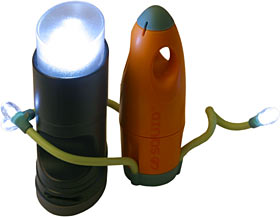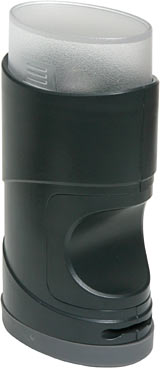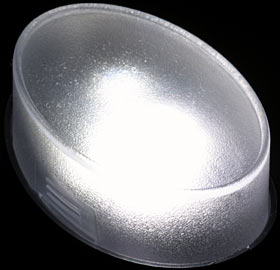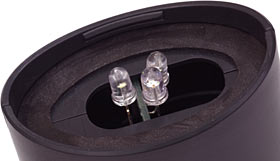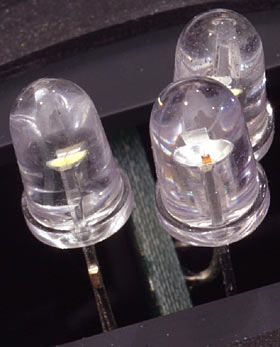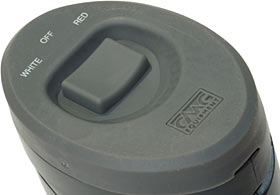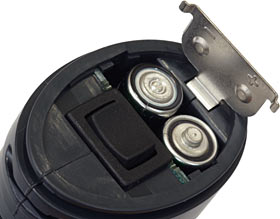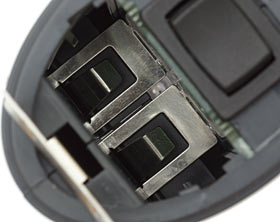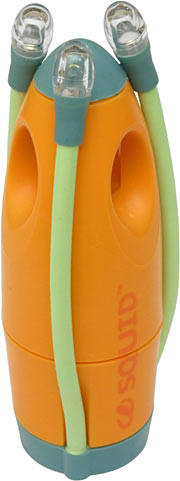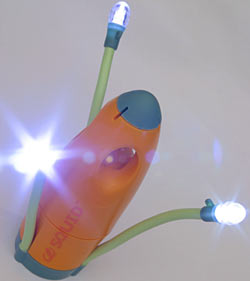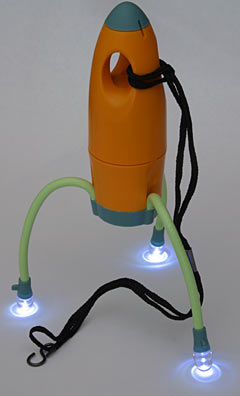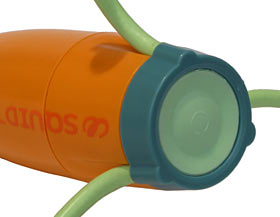
Bonfire Blaze and Squid Light
Review date: 23 July 2003.Last modified 03-Dec-2011.
LED flashlights are fine things, but sometimes a flashlight isn't what you need. Sometimes - well, often, actually - you want a small, portable light that works like a normal wide-angle lamp.
You can clench a flashlight in your teeth or tuck it behind your ear (assuming a very small flashlight or a very big ear...), or you can strap on a headlamp, or you can point a beefy flashlight at a pale-coloured object, like the ceiling or the roof of your tent, and get reasonable area lighting that way. But if you find yourself doing that sort of thing a lot, then something more candle-like is in order.
Like one of these, for instance.
On the left, CMG Equipment's Bonfire Blaze, distributed here in Australia by Spelean. It's the updated version of the original Bonfire "tent light", which I reviewed here.
The tentacular object affectionately hugging the Bonfire is a Squid Light.
These two lights are in the same price ballpark. The Bonfire Blaze goes for under $US30 plus shipping (from here, for instance; CMG gear is sold in lots of places both on-line and off), while the manufacturers of the Squid sell it directly for $US29.95 plus shipping. You can get Squids from other fine gadget vendors, too, like ThinkGeek; they've got them for $US24.99 plus shipping.
So which one's better?
Read on.
Blazing... uh... LEDdles?
The only obvious difference between the Bonfire Blaze and the original Bonfire is the Blaze's darker, slate-grey body, and slightly clearer top diffuser.
The new model works the same way, too, except instead of three amber LEDs under the diffuser throwing a friendly campfire sort of light, there's...
...one red LED...
...and two white ones. The old Bonfire has a three-position switch that gives you low brightness, off, and high brightness; the Blaze has red, off, and white.
So you get the choice of night-vision-preserving red illumination, or proper colour rendering from the white LEDs. White light is more useful than any one colour, whenever you need to distinguish colours from each other. Map reading, for instance, is difficult under coloured light; everything shows up as shades of the light colour you're using, and pigments that reflect none of the illuminating light (green ink under red light, for instance) look black.
The Blaze's white light is a lot brighter than its red. The above pictures make the white look only mildly brighter, but the exposure time for the red image is six and two thirds as long as the exposure for the white one.
This is the white mode at the same exposure as the red-mode shot, above.
As with the previous Bonfire, you can snap the Blaze's diffuser off if you want to use the light as a directional flashlight, or if you want to bend the LEDs away from their default all-pointing-up position to get more even lighting, or if you're just curious.
The LEDs are standard 5mm high intensity units. There's one white LED on each side (they're the ones with the yellow phosphor blob; the front-right LED in this picture is the phosphor-less red one), so you can bend them outwards each way if you want a wider light pattern.
The other end of the Blaze has the same sort of rubber cap on it as the last Bonfire. The cap makes it a bit tricky to operate the switch, but it keeps water out; it, along with a rubber gasket under the diffuser at the other end, make this light pretty much rainproof, though it's not truly waterproof. It's at its most weather-resistant when it's hanging with the diffuser downwards.
Remove the rubber cap and you can see the switch, and also get access to the mildly cheesy push-and-slide retainer for the two AA cells that power the Blaze.
When I hooked my multimeter up to the Blaze, it drew about 100 milliamps (mA) through the meter in red mode, and about 260mA in white mode, from two fresh alkaline AAs. The drain without the extra resistance of the meter would be a bit higher.
This isn't a tremendously high load for AAs to bear; the load will also fall as the batteries age, so CMG's claims of 20 hour battery life in white mode and 72 hours in red mode aren't at all outrageous. As with all other LED lights, the Blaze gets dimmer when the batteries get flatter, but it doesn't change colour. Incandescent bulbs get redder as they dim, sliding more and more of their output right down into the invisible infra-red. The redder the light is, the less useful it is. LEDs don't have this problem.
100mA-plus into a single 5mm LED with no heat sinking, by the way, is mean; splitting 260mA between two would verge on the criminal. High intensity LEDs without extra cooling really shouldn't be run at any more than 30mA if you want them to live as long as their manufacturers promised.
Fortunately, the Blaze isn't actually giving its LEDs, at least the white ones, as large a Doc Marten to the beanbag as its current draw suggests. The white LEDs are running from a step-up converter that takes the three volts maximum that the two AAs deliver and converts it to the 3.6-odd volts the LEDs want. The red LED wants rather less than three volts, and so probably just has a series resistor, and is being driven rather darn hard, but the white LEDs probably aren't being driven any harder. They still get very warm, from fresh batteries, though.
At full brightness, the old amber-LED Bonfire drives its LEDs at something like 60mA each, from fresh AAs. That's still on the high side, but not ludicrously so; taking into account the lower current they'll draw from flatter batteries, the amber LEDs should still be good for most of the hundred thousand hours they're probably specified to last before dropping to 80% brightness, and they should have lots of life left after that.
I don't know how much shorter the lifespan of the Blaze's LEDs will be; it'll depend on how often you change the batteries. There are less than 9000 hours in a whole year, though, so I doubt any Blaze customer is actually going to wear out the LEDs. Maybe their kids will, if they inherit the light.
As you'd expect from such imposing current draw, both of the Blaze's modes are more than bright enough to usefully illuminate a tent, or indeed a good-sized caravan, if you hang the Blaze from the ceiling with the provided lanyard. The light stays decently bright for many hours, too. The white mode's broad-spectrum light is far superior to the old Bonfire's amber illumination.
The only real problem with the Blaze, as with the earlier Bonfire, is these terminals at the inside end of the battery bay. They're not coil springs, but simple bent-sheet-metal fabrications. If you drop the light diffuser-down from any significant distance onto a firm surface, the two AA cells will squash these terminals flat. This leaves the batteries rattling around in the bay, and gives you an intermittent or completely non-functional light, depending on how hard you dropped it.
This problem is not an obscure and unlikely one, because this light is made to hang with its diffuser pointing down. It'll be a lot less likely to drop in this particularly unfortunate way if you use it standing on a table or just sit it on the floor, but if you hang it up in your tent, you're asking for it.
The flat-terminals problem is easy to solve, if you've got an appropriate implement to hand and can see what you're doing. Without a tool to reach into the battery bay and hook onto the terminal tabs, and without any light to see them by, though, you'd be out of luck.
On to the tentaculo-light.
Squidding about
Like the Bonfires, the Squid Light has three LEDs, two brightness modes, and can stand on a table or hang from the ceiling.
You're not likely to mistake the Squid for a Bonfire, though.
The Squid's three white LEDs are attached to its streamlined plastic body with plastic-sheathed goosenecks about nine centimetres (3.5 inches) long. The arms are quite stiff, but stay where you put them when you bend them, and you can bend them back on themselves to less than a one centimetre radius if you put a bit of thumb-power into it.
If you want the lights to point pretty much forward, they've got tabs on the side that fit into slots in the nose of the Squid's body, and stick there.
So you can aim the lamps pretty much wherever you like. All one way, all different ways; no problem.
The clear lenses over the 5mm LEDs are made from polycarbonate, and thus probably quite a bit stronger than they need to be. The LEDs themselves aren't what you'd call fragile in the first place.
The lamps throw a beam with a quite tight central hot spot, surrounded by a large faint spill area. Each lamp's spot is only about 20cm (eight inches) wide at one metre, so it's difficult to use the Squid as a true area light, like the Bonfires. The flipside of this is that a bit of tentacle-bending should let you put more light where it's actually needed.
To hang the Squid, by the way, you thread a provided lanyard...
...through the holes in the top of the body. The lanyard has a handy little metal hook.
In this configuration, the Squid looks like nothing so much as a Philippe Starck juicer.
You turn the Squid on and off with this rubber-covered button in its base. Click the button once and you're in low brightness mode; click it again and you get high brightness; click it once more and the Squid turns off again.
The click, by the way, doesn't come from the switch itself. If you press the button gently you can change modes without clicking anything. The clicker is presumably just there to let you know you've done something.
The Squid runs from three AAA cells, and you get at them by unscrewing its body. The body has an integral stop that ensures an internal contact lines up properly when it's screwed on; it's a neat design that should last well.
The screw thread is quite stiff, but that's probably a good thing. The manufacturers only say the Squid is "water resistant", but the tight thread and rubber end caps ought to make it at least as rainproof as the Bonfires.
Multimetering the Squid told me its low power mode draws a miserly 8mA through the meter, and its high power mode's 90mA, from fresh AAAs.
AAA cells have well under half the capacity of AAs, and also have lousier performance at high current draws, but 90mA isn't hideously mean to them. The Squid's manufacturer alleges 20 hour run time in high mode and more than seven days in low; this isn't over the top.
The Squid's low power output is good enough for tent lighting if your eyes are accustomed to the dark, but this is really only meant to be a "personal" mode for one user, and it's fine for that. You could read a book by it with no trouble at all.
The Squid's high power mode, in contrast, is up there for total light output with the Bonfire Blaze's white output. This doesn't surprise me. Three LEDs at 30mA can match two LEDs at 90mA, or whatever the Blaze is running its white LEDs at; LEDs get less and less efficient the harder you drive them, and the Squid has no light-eating diffuser between its LEDs and the world.
Because the Squid has no diffuser, though, it also has quite directional output, no matter what you do with its three arms. A Blaze with its white LEDs bent outwards gives much more even light than a Squid.
The Squid can be set up to just light your book and not annoy your tent-mate, though.
Overall
I like both of these lights.
The Squid is, obviously, the glamour boy. If you're looking for a funky yet useful gift (possibly for yourself), it wins. It's more solidly constructed than the Bonfire Blaze, too; the Squid's bottom battery terminals are sensible springs, and it's body's rock solid. So you ought to be able to drop it and kick it all you want, within reason, without damage.
The Squid's aim-able lights are quite useful, too. It's not easy to aim them if the Squid's hanging from the roof, but if it's sitting on a table the three arms are great.
And yes, you can spend time just playing with them.
Well, I did, anyway.
Hush.
The Bonfire Blaze, on the other hand, has more even wide-area output, bigger batteries (though no dim-from-the-start "personal" mode), and two light colours. People who want to preserve their night vision like red lights a lot; the Blaze gives you a red light and a white one in one package.
If you want a candle-like light, the Blaze is better. If you want three little spot beams and considerable toy and gadget value, the Squid wins.
I'm going to find both of them useful.
Bonfire Blaze kindly provided by Spelean (the CMG Equipment site is here).
Squid Light kindly provided by Montane, Inc (their Squid site is here).
